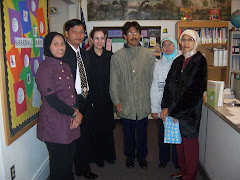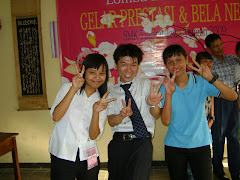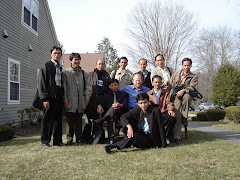Guru adalah anggota masyarakat yang sangat berjasa. Ia memilih membimbing
tunas-tunas muda lebih dari sekedar mengajar. Ia merancang suatu pemikiran
cemerlang, bertindak dan memecahkan persoalan yang relevan.
Berbagai metode dikembangkan oleh guru. Salah satunya adalah accelerated learning (teaching).
Melalui penerapan teknik accelerated learning di kelas, anak-anak walau
memiliki kemampuan kurang tampak seperti benih yang hendak tumbuh.
Langkah demi langkah accelerated teaching dapat diringkas dalam satu
kata: MASTER. Dengan M:
Mind, A: Acquiring the fact, S: Search out the
meaning, T: Trigger the memory, E: Exhibit
what you know dan R: Reflecting.
Ciptakan
Suasana Hati yang Tepat (MIND)
Hubungan
yang baik antara guru dan murid adalah salah satu faktor penentu apakah
pembelajaran dapat berjalan dengan menyenangkan dan efektif. Sangat penting meluangkan waktu bersama siswa dan menjamin siswa
dapat menerima, bebas stres dan suasana hati gembira.
Berikut ini adalah beberapa cara membangkitkan motivasi siswa:
v Jelaskan pada siswa cara kerja
otak mereka dan gaya belajar.
v Tekankan relevansi.
v Visualisasikan kualitas hasil.
v Beri siswa kepercayaan mengatur.
v Beri jaminan rasa aman untuk
kesalahan.
v Sugesti keberhasilan.
v Pasang poster ‘sukses’.
Dapatkan
Informasi (Acquiring the Fact)
Saat guru
menyampaikan informasi baru, wajar bila siswa mulai melakukan internalisasi.
Siswa melakukan internalisasi dengan cara yang berbeda-beda sehingga dapat
menimbulkan kegaduhan. Bila guru berusaha menghentikan kegaduhan ini, dapat
menghambat pemahaman siswa. Cara yang efektif untuk mengurangi kegaduhan
adalah berhenti dan menganjurkan siswa berdiskusi dengan teman sebelahnya
sejenak. Pada kesempatan ini guru dapat membantu pemahaman siswa tertentu.
Dalam
suasana seperti ini guru dapat mengambil sikap proaktif:
v Ide utama; menjelaskan kembali ide
utama sehingga membantu proses internalisasi.
v Kerja sama informal; kembangkan
kerja sama informal antara siswa-guru maupun antar siswa.
Temukan
Makna (Search Out the Meaning)
Tujuan
pembelajaran bukan sekedar transfer ilmu, tetapi membantu siswa mengembangkan
pemahamannya sendiri sampai ke pemahaman yang benar tentang subjek.
Untuk membantu siswa menangkap makna, guru dapat melakukan:
v Berikan Analogi; memberikan
gambaran-gambaran yang lebih akrab atau dikenal oleh siswa.
v Kerangka visual pikiran; Anda dapat membuat diagram materi yang sedang
diajarkan atau peta pikiran. Dengan demikian hubungan antar tiap bagian dapat tervisualisasikan.
v Pemikiran mendalam; mungkin Anda
dapat membantu siswa mengkaji lebih detil. Anda dapat menunjukkan contoh
konkret atau bukti formal.
v Sequence Shuffle untuk tipe kinestesik; untuk tipe
siswa kinestesik, berilah kesempatan agar dapat melakukan gerakan tertentu.
Biarkan saja ia pindah posisi untuk merenungkan lebih dalam.
v Arahan imajinasi; bangun percaya
diri siswa. Picu imajinasinya. Dukung dan arahkan imajinasi ke makna terdalam
atau lebih.
v Pertanyaan tantangan; munculkan beberapa pertanyaan yang memancing rasa
penasaran. Tahap demi
tahap semakin dalam.
v Pembelajaran Interpersonal.
v Bantu membangun kecerdasan
intrapersonal.
v Proyek perseorangan yang
melibatkan banyak subjek.
Memancing
Memori (Trigger the Memory)
Gunakan review
berputar. Anda dapat meminta seorang siswa untuk menyebutkan apa yang paling ia
sukai dalam pelajaran yang baru berlangsung. Pernyataan
siswa itu kemudian disambung dengan siswa yang lain. Anda dapat berperan
sebagai fasilitator.
Salah satu metode terbaik untuk memori adalah circuit learning. Anda
dapat melakukan pengulangan- pengulangan secara terencana. Misalnya siswa dapat
membuat peta pikiran dari suatu subjek. Setiap hari peta pikiran itu diamati
secara sepintas. Jika ingin dikomentari, langsung ditambahkan.
Ungkapan Apa yang Diketahui (Exhibit)
Siswa jelas perlu menyatakan apa yang telah dipelajari dan seberapa
baik. Lakukan test untuk feedback.
v Tantangan yang sesuai
v Swap Shop
v Pernyataan pribadi
v Rekaman pencapaian
v Nilai
Refleksikan Apa yang Telah Dipelajari (Reflect)
Cara paling sederhana untuk memperbaiki kinerja Anda dan siswa adalah
melakukan renungan. Renungkan hal-hal apakah yang dapat diperbaiki lagi.
Refleksi guru. Renungkan apakah metode yang kita
terapkan telah sesuai sasaran. Renungkan pula apakah target kita tercapai.
Bagaimana cara memperbaikinya. Dengan perenungan ini, setahap demi setahap kita
akan menuju titik optimal.
Refleksi siswa. Tuntunlah siswa untuk merenungi apa yang telah ia
pelajari. Apakah ia telah belajar dengan cara yang efektif. Jadilah fasilitator
untuk meningkatkan kinerja belajar sisw
 Hanami (
Hanami ( You’re probably wondering, why is the sakura (さくら) so fascinating to Japanese people? Sakura (さくら) flowers wither away almost as soon as they bloom. For centuries, the sakura (さくら) flower has been the metaphor for life. To the Japanese, life is considered transient, ephermal, or short lived. It’s kind of depressing, but at the same time it makes you realize how precious life is. Sometimes, the sakura (さくら) is used as a metaphor for youth as well. To the Japanese, youth is fleeting and that’s what makes it so bitter sweet.
You’re probably wondering, why is the sakura (さくら) so fascinating to Japanese people? Sakura (さくら) flowers wither away almost as soon as they bloom. For centuries, the sakura (さくら) flower has been the metaphor for life. To the Japanese, life is considered transient, ephermal, or short lived. It’s kind of depressing, but at the same time it makes you realize how precious life is. Sometimes, the sakura (さくら) is used as a metaphor for youth as well. To the Japanese, youth is fleeting and that’s what makes it so bitter sweet. Speaking of youth, sometimes you’ll see a group of college students gathering under the sakura (さくら) trees at night. When the gathering is at night it’s called yozakura (よざくら), which literally means “night sakura”. Colored lanterns are hung everywhere, which makes the atmosphere just as beautiful as the daytime. The most popular hanami (
Speaking of youth, sometimes you’ll see a group of college students gathering under the sakura (さくら) trees at night. When the gathering is at night it’s called yozakura (よざくら), which literally means “night sakura”. Colored lanterns are hung everywhere, which makes the atmosphere just as beautiful as the daytime. The most popular hanami (












